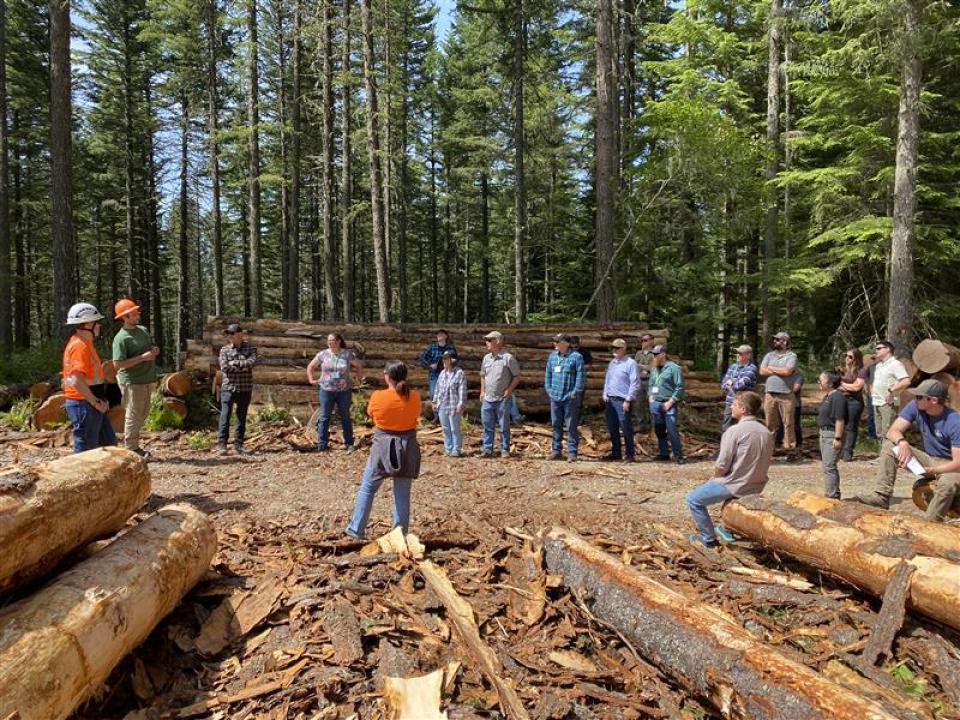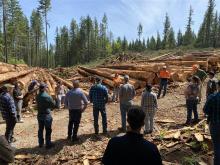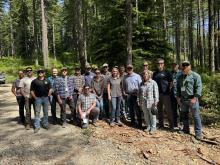Authored by Kyle Sullivan-Astor, Federal Forest Restoration Program Lead with the Oregon Department of Forestry
The Council of Western State Foresters (CWSF) Good Neighbor Authority (GNA) Committee gathered June 10–12, 2025, at Chemeketa Eola Event Center in Salem, Oregon, for its third annual meeting. Established by CWSF in 2017, the GNA Committee exists to share knowledge between western state forestry agencies and serve as a resource to state foresters.

GNA leads from Arizona, California, Colorado, Idaho, Montana, New Mexico, North Dakota, Oregon, Washington, and Wisconsin were joined by USDA Forest Service (Forest Service) Washington Office & Regions 6 leadership and staff; Bureau of Land Management (BLM) grants management staff; CWSF staff and State Forester Advisor Tom Torres; and partner organizations
This year’s meeting occurred during a period of significant transition within the Forest Service and BLM in policy, direction, and personnel. Although the federal agencies intend to conduct more active forest management moving forward, they will pursue that goal with reduced staffing, particularly at their headquarters and regional offices.
Over three days, meeting participants:
- Discussed federal policy changes and opportunities state forestry agencies have to engage earlier in federal land management planning.
- Investigated a multi-state GNA agreement modeled on existing mutual aid agreements.
- Presented a toolkit to overcome communication barriers in cross-agency work.
- Explored successes and challenges related to GNA work in practice on the Mt. Hood National Forest Car GNA timber sale.
- Learned from nonprofits, contractors, and forest-products companies on how state forestry agencies can best partner for shared success.
The meeting was kicked off by Kyle Williams, Oregon Department of Forestry (ODF) Deputy Director, and Jacque Buchanan, Forest Service Pacific Northwest Regional Forester. Williams highlighted the worsening wildfire trends in Oregon and landscape scale GNA projects for mitigating wildfire risk and creating resilient forests. Buchanan acknowledged the significant transition the Forest Service is undergoing and highlighted the importance of the agency’s partnership with state forestry agencies as a mechanism to achieve mutual goals. She described the “mutually beneficial, symbiotic relationship between states and the Forest Service” as essential for success moving forward. She also noted “we cannot continue with the status quo, we have to do more”, referring to active management efforts, and that the Forest Service will rely on its partners to achieve more than what they are capable of alone.
The second day began with a State Forester panel consisting of Tom Torres (AZ), George Geissler (WA), Marcus Warnke (SD), and Kyle Williams (OR). Panel members discussed the tension between the federal government asking more of states under GNA and the President’s budget proposing the elimination of long-standing state, private, and tribal forest programs; for many states these programs support the same staff that work under GNA.
“As we move into the future, I want a greater say in where we are doing work on the landscape, it's not just to meet a target that a forest supervisor has or a regional forester has, but to pursue projects that are aligned with what Arizona’s priorities are… I see shared decision making and shared intent guiding us moving forward.” - Tom Torres
“We can’t be a passive observer of what happens next…states have to be involved in helping shape the future of forestry and fire protection on lands regardless of ownership.”- Kyle Williams
Later in the day, the Forest Service Washington Office provided an update on GNA amendments made via the Expanding Public Lands Outdoor Recreation Experiences (EXPLORE) Act, an overview of the National Active Management Strategy, and Forest Service personnel changes.
The National Active Management Strategy (May 2025) sets the goal of increasing timber volume offered by 25% to 4 billion board feet and calls for “expanding the use of shared stewardship, partner agreements, and Good Neighbor Authority to increase the capacity of States, Tribes, and partners as well as to better respond to their needs.” The Forest Service shared that states can expect Forest Service regional offices to release tiered active management strategies by August 2025 that will include direction on forest-level five-year plan development. GNA timber sales currently make up approximately 11% of all Forest Service timber sales sold, and to fulfill this strategy, the Forest Service is targeting GNA to be 15% of all Forest Service timber sales sold.
A highlight from the third day of the meeting was the panel discussion centered around partnerships with nonprofits, forest industry, and forest contractors. Participants learned how state forestry agencies can leverage GNA to meet partner organization needs, advance federal agency objectives, while fulfilling their own missions. Groups and companies outside of government that have an interest in the health of our federal forests and the communities that surround them, such as those represented on the panel, are well-positioned to be a strong partner to both states and federal agencies.
The BLM session highlighted grants management procedural steps and processes for GNA activities. Of note, a key difference from the Forest Service GNA model: BLM GNA activities are authorized by a Grants Management Officer rather than signed by the field or district manager and the state cooperator. Importantly, states can reopen scope, budget, and terms after award; a detail many participants didn’t know was possible.
Against a backdrop of change at the federal level, this annual meeting was a great opportunity for western state forestry agencies to learn from one another and lock in tangible next steps for the GNA Committee. Participants left Salem with the goal of drafting a response to the Forest Service National Active Management Strategy, developing a template state-to-state mutual aid agreement for work under GNA, developing a BLM GNA whitepaper, and continuing to advise western state foresters on federal forest resilience, shared stewardship, and GNA.
To learn more about the GNA Committee, visit https://www.westernforesters.org/committees/good-neighbor-authority-committee, and to learn more about GNA, visit https://www.thewflc.org/partnerships/gna-information-and-resources.


